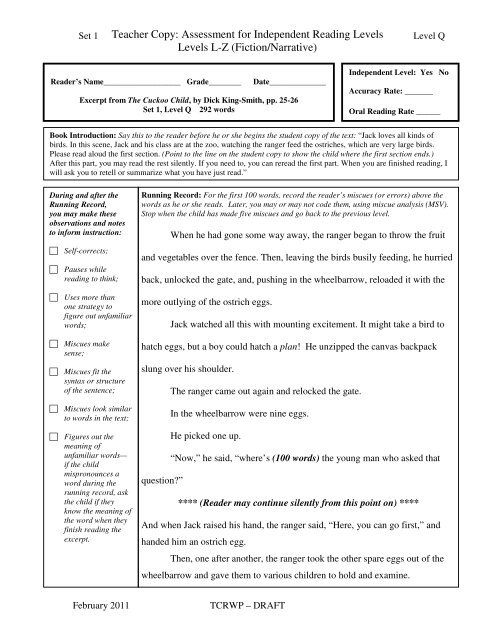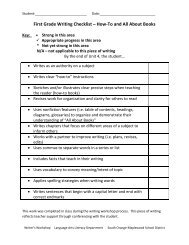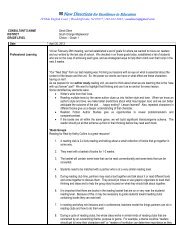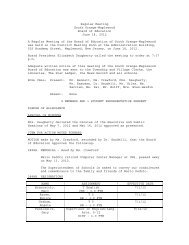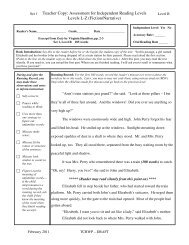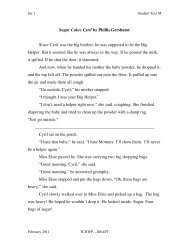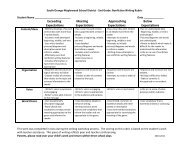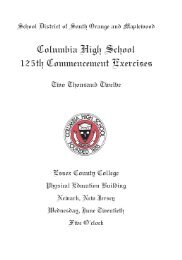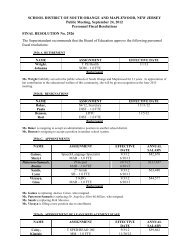The Cuckoo Child (Running Record).
The Cuckoo Child (Running Record).
The Cuckoo Child (Running Record).
You also want an ePaper? Increase the reach of your titles
YUMPU automatically turns print PDFs into web optimized ePapers that Google loves.
Set 1<br />
Teacher Copy: Assessment for Independent Reading Levels<br />
Levels L-Z (Fiction/Narrative)<br />
Level Q<br />
Reader’s Name___________________ Grade________<br />
Date______________<br />
Excerpt from <strong>The</strong> <strong>Cuckoo</strong> <strong>Child</strong>, by Dick King-Smith, pp. 25-26<br />
Set 1, Level Q 292 words<br />
Independent Level: Yes No<br />
Accuracy Rate: _______<br />
Oral Reading Rate ______<br />
Book Introduction: Say this to the reader before he or she begins the student copy of the text: “Jack loves all kinds of<br />
birds. In this scene, Jack and his class are at the zoo, watching the ranger feed the ostriches, which are very large birds.<br />
Please read aloud the first section. (Point to the line on the student copy to show the child where the first section ends.)<br />
After this part, you may read the rest silently. If you need to, you can reread the first part. When you are finished reading, I<br />
will ask you to retell or summarize what you have just read.”<br />
During and after the<br />
<strong>Running</strong> <strong>Record</strong>,<br />
you may make these<br />
observations and notes<br />
to inform instruction:<br />
Self-corrects;<br />
Pauses while<br />
reading to think;<br />
Uses more than<br />
one strategy to<br />
figure out unfamiliar<br />
words;<br />
Miscues make<br />
sense;<br />
Miscues fit the<br />
syntax or structure<br />
of the sentence;<br />
Miscues look similar<br />
to words in the text;<br />
Figures out the<br />
meaning of<br />
unfamiliar words—<br />
if the child<br />
mispronounces a<br />
word during the<br />
running record, ask<br />
the child if they<br />
know the meaning of<br />
the word when they<br />
finish reading the<br />
excerpt.<br />
<strong>Running</strong> <strong>Record</strong>: For the first 100 words, record the reader’s miscues (or errors) above the<br />
words as he or she reads. Later, you may or may not code them, using miscue analysis (MSV).<br />
Stop when the child has made five miscues and go back to the previous level.<br />
When he had gone some way away, the ranger began to throw the fruit<br />
and vegetables over the fence. <strong>The</strong>n, leaving the birds busily feeding, he hurried<br />
back, unlocked the gate, and, pushing in the wheelbarrow, reloaded it with the<br />
more outlying of the ostrich eggs.<br />
Jack watched all this with mounting excitement. It might take a bird to<br />
hatch eggs, but a boy could hatch a plan! He unzipped the canvas backpack<br />
slung over his shoulder.<br />
question?”<br />
<strong>The</strong> ranger came out again and relocked the gate.<br />
In the wheelbarrow were nine eggs.<br />
He picked one up.<br />
“Now,” he said, “where’s (100 words) the young man who asked that<br />
**** (Reader may continue silently from this point on) ****<br />
And when Jack raised his hand, the ranger said, “Here, you can go first,” and<br />
handed him an ostrich egg.<br />
<strong>The</strong>n, one after another, the ranger took the other spare eggs out of the<br />
wheelbarrow and gave them to various children to hold and examine.<br />
February 2011<br />
TCRWP – DRAFT
Set 1<br />
Teacher Copy: Assessment for Independent Reading Levels<br />
Levels L-Z (Fiction/Narrative)<br />
Level Q<br />
“Let me!” “Let me!” “Give it here!” “Let me go first!” cried the boys and girls as they<br />
competed to hold an egg, and in the hubbub and confusion nobody noticed what Jack was doing or<br />
heard him zip his backpack shut.<br />
“Now, now, children, that’s enough!” said (200 words) the teacher. “Put all the eggs back in the<br />
wheelbarrow now.” She turned to the ranger and said, “What will you do with these?”<br />
“Often we send some to other safari parks or zoos,” said the ranger, “but actually these will be<br />
fed to our big snakes, the pythons and the boa constrictors. Now then, have you all put your eggs<br />
back?”<br />
“Yes!” chorused the children. Jack said nothing.<br />
“Thank you for your trouble,” said the teacher.<br />
“Bye-bye then,” said the ranger, and off he went. In the wheelbarrow were eight eggs.<br />
(292 words)<br />
Total miscues including<br />
self-corrected: _____<br />
Self-corrections: _____<br />
Miscues reader did not<br />
self-correct: ______<br />
Accuracy Rate: Circle the number of miscues the reader did not self-correct.<br />
100% 99% 98% 97% 96%<br />
0 miscues 1 miscue 2 miscues 3 miscues 4 miscues<br />
96%-100% accuracy is necessary to determine the reader’s independent reading level.<br />
Try a lower level text if the reader made 5 or more miscues.<br />
* If the child makes the same miscue repeatedly, count it as one miscue.<br />
Literal and Inferential Retelling or Summary<br />
Say, “Please retell or summarize what you just read.” Write notes regarding the student’s retelling or summary on the<br />
back of this page. If the student has trouble getting started, you can prompt him/her. Make a note that you prompted<br />
the student.<br />
Use the Retelling Rubric and Sample Student Responses to determine if the child’s retelling and responses to the<br />
comprehension questions are acceptable. If a student answers a comprehension question as part of the retelling you do<br />
not have to ask him/her that question. If a student is not able to retell but is able to answer the comprehension<br />
questions, note that this student will need extra work on how to retell a story.<br />
February 2011<br />
TCRWP – DRAFT
Set 1<br />
Teacher Copy: Assessment for Independent Reading Levels<br />
Levels L-Z (Fiction/Narrative)<br />
Comprehension Questions Section: Analyze the student’s retelling/summary to see if it contains information that answers<br />
each question below. If a question was not answered in the retelling, ask it and record the student’s response.<br />
1. Literal Question: What does the ranger say he will do with the spare eggs?<br />
2. Literal Question: Did anybody notice that one of the eggs is missing at the end of the passage? How can you tell?<br />
3. Inferential Question: <strong>The</strong> story says, “It might take a bird to hatch eggs, but a boy could hatch a plan!” What was Jack’s<br />
plan?<br />
4. Inferential Question: What do you think Jack did with one of the eggs?<br />
Level Q<br />
Oral Reading Fluency Scale – Circle the Appropriate Level<br />
Fluent<br />
Level<br />
4<br />
Level<br />
3<br />
Reads primarily in larger, meaningful phrase groups. Although some regressions, repetitions, and deviations from text<br />
may be present, these do not appear to detract from the overall structure of the text. Preservation of the author’s syntax<br />
is consistent. Most of the text is read with expressive interpretation.<br />
Reads primarily in three or four-word phrase groups. Some small groupings may be present. However, the majority of<br />
phrasing seems appropriate and preserves the syntax of the author. Some expressive interpretation is present; this may<br />
be inconsistent across the reading of the text.<br />
Non fluent<br />
Level<br />
2<br />
Level<br />
1<br />
Reads primarily in two-word phrases with some three or four-word groupings. Some word-by-word reading may be<br />
present. Word groupings may seem awkward and unrelated to larger context of sentence or passage. Beginning a little<br />
expressive interpretation, frequently first seen when reading dialogue.<br />
Reads primarily word-by-word. Occasional two-word or three-word phrases may occur—but these are infrequent and/or<br />
they do not preserve meaningful syntax. No expressive interpretation.<br />
Adapted from: U.S. Department of Education, Institute of Education Sciences, National Center for Education Statistics, National<br />
Assessment of Educational Progress (NAEP), 2002 Oral Reading Study.<br />
Level Q Benchmarks for Oral Reading Rate (Words Per Minute)<br />
Oral reading rate is the number of words per minute the reader reads with accuracy, intonation and meaningful phrasing.<br />
Level 1<br />
Needs Support<br />
Level 2<br />
Approaches Standards<br />
Level 3<br />
Meets Standards<br />
Level 4<br />
Exceeds Standards<br />
74 wpm or less 75-104 wpm 105-140 wpm 141 wpm or more<br />
Please refer to the Benchmarks for Student Progress for details regarding Oral Reading Rate.<br />
Final Score<br />
Yes No Was the reader’s accuracy rate at least 96%?<br />
Yes No Did the student read with fluency? (a score of 3 or 4 on the Oral Reading Fluency Scale)<br />
Yes No Did the reader correctly answer at least 3 questions in the Comprehension Questions Section?<br />
Yes No Did the retelling/summary express the important things that happened in the text?<br />
Is this the student's independent reading level?<br />
• If you did NOT answer “yes” to all four questions in this Final Score box, try an easier text. Keep moving to easier texts until you find the level at<br />
which you are able to answer “yes” to all four questions in the Final Score box.<br />
• If you circled four “yes” answers in this Final Score box, the student is reading strongly at this level. However, it is possible that the student may also<br />
read strongly at a higher level. Keep moving to higher passages until you can no longer answer “yes” to all four questions. <strong>The</strong> highest level that<br />
showed strong reading is the independent reading level. For example, you might find that you answered “yes” to all four questions in the Final Score<br />
box for level P, then a “yes” to all four questions for level Q, but only three “yes” answers for level R. Level Q is the highest passage on which you<br />
were able to answer “yes” to all four questions in the Final Score box. Level Q is the current independent reading level for the student.<br />
February 2011<br />
TCRWP – DRAFT


